The Intel Skylake-X Review: Core i9 7900X, i7 7820X and i7 7800X Tested
by Ian Cutress on June 19, 2017 9:01 AM ESTBenchmarking Performance: CPU Rendering Tests
Rendering tests are a long-time favorite of reviewers and benchmarkers, as the code used by rendering packages is usually highly optimized to squeeze every little bit of performance out. Sometimes rendering programs end up being heavily memory dependent as well - when you have that many threads flying about with a ton of data, having low latency memory can be key to everything. Here we take a few of the usual rendering packages under Windows 10, as well as a few new interesting benchmarks.
Corona 1.3
Corona is a standalone package designed to assist software like 3ds Max and Maya with photorealism via ray tracing. It's simple - shoot rays, get pixels. OK, it's more complicated than that, but the benchmark renders a fixed scene six times and offers results in terms of time and rays per second. The official benchmark tables list user submitted results in terms of time, however I feel rays per second is a better metric (in general, scores where higher is better seem to be easier to explain anyway). Corona likes to pile on the threads, so the results end up being very staggered based on thread count.
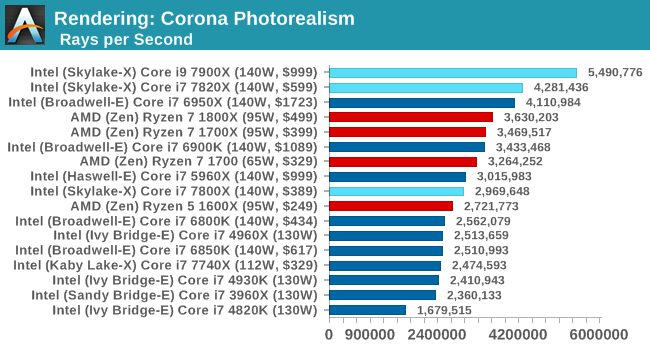
Blender 2.78
For a render that has been around for what seems like ages, Blender is still a highly popular tool. We managed to wrap up a standard workload into the February 5 nightly build of Blender and measure the time it takes to render the first frame of the scene. Being one of the bigger open source tools out there, it means both AMD and Intel work actively to help improve the codebase, for better or for worse on their own/each other's microarchitecture.
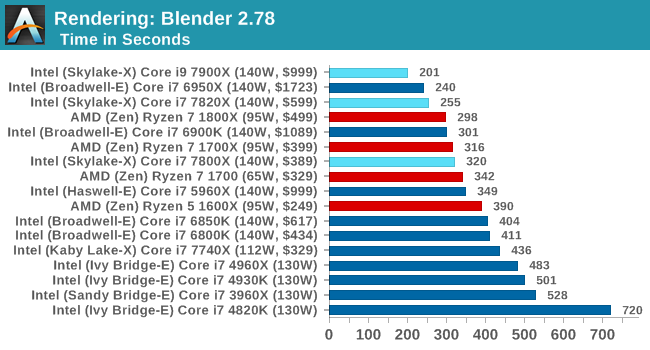
LuxMark
As a synthetic, LuxMark might come across as somewhat arbitrary as a renderer, given that it's mainly used to test GPUs, but it does offer both an OpenCL and a standard C++ mode. In this instance, aside from seeing the comparison in each coding mode for cores and IPC, we also get to see the difference in performance moving from a C++ based code-stack to an OpenCL one with a CPU as the main host.
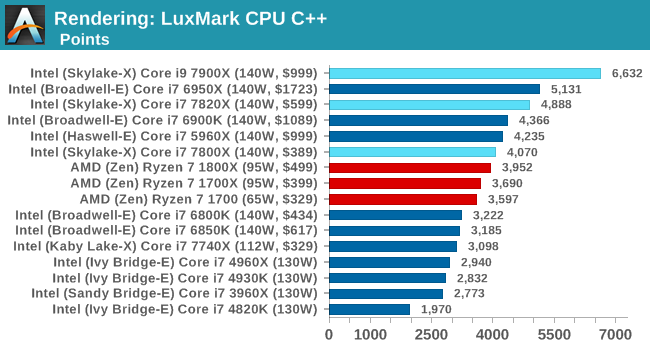
POV-Ray 3.7b3
Another regular benchmark in most suites, POV-Ray is another ray-tracer but has been around for many years. It just so happens that during the run up to AMD's Ryzen launch, the code base started to get active again with developers making changes to the code and pushing out updates. Our version and benchmarking started just before that was happening, but given time we will see where the POV-Ray code ends up and adjust in due course.
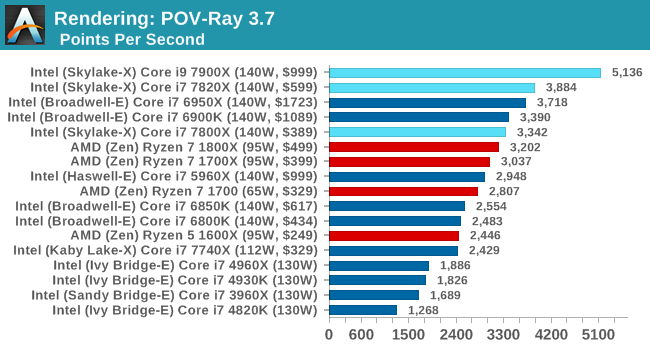
Cinebench R15
The latest version of CineBench has also become one of those 'used everywhere' benchmarks, particularly as an indicator of single thread performance. High IPC and high frequency gives performance in ST, whereas having good scaling and many cores is where the MT test wins out.
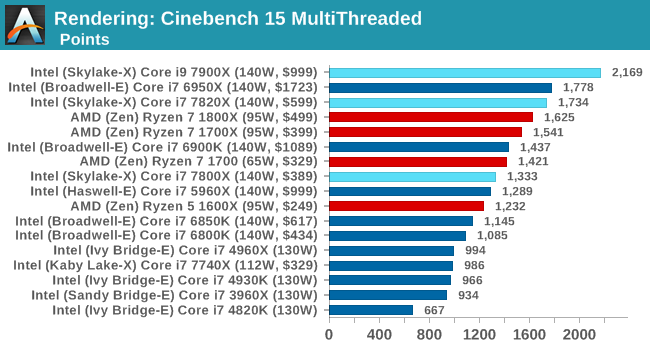
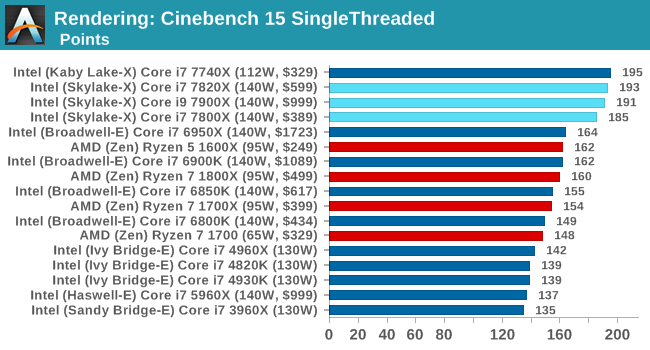










264 Comments
View All Comments
halcyon - Monday, June 19, 2017 - link
Thank you for the review. The AVX512 situation was a bit unclear. Which models have which AVX512 support of the now released chips (and the future, yet to be released chips). It would be interesting to see AVX512 specific article once the chips are out and we have (hopefully) some useful AVX512-optimized software (like encoding).For myself, decision is easy now to postpone, until ThreadRipper is out. The thermals are just out of whack and for my workloads, the price is not justified. Here's hoping Threadripper can deliver more for same price or less.
Bulat Ziganshin - Monday, June 19, 2017 - link
all skl-x has avx-512 support. i9 cpus has double fma512 engines, but as i guess - that's only difference, i.e. remaining 512-bit commands (such as integer operations) will have the same throughput on i7 and i9but i may be wrong and it will be really very ibteresting to check throughput of all other operatins. probably Anand can't do that and we will need to wait until Agner Fog will reach these spus
halcyon - Monday, June 19, 2017 - link
Thanks. Many questions remain: AVX512F vs AVX512BW, which are supported now, which in the future? What is the difference? How does it compare to Knights Landing? Are number of AVX units tied to number of cores? What is the speed differential in AVX512 loads? What is the oc limitation from AVX512 support? etc.nevcairiel - Monday, June 19, 2017 - link
Those Knights Landing/Knights Mill specific AVX512 instructions are actually very specific to the work-loads you would see on such a specialized CPU. The instructions chosen for Skylake-X and future Cannon Lake more closely match what we already know from AVX/AVX2.For the "types" of AVX512, basically its split into several sub-instruction sets, all containing different instructions. AVX512 will always include F, because thats the basis for everything (instruction encoding, 512-bit registers, etc). BW/DQ include the basic instructions we know from AVX/AVX2, just for 512-bit registers. SKL-X supports all of F, CD, BW, DQ, VL.
Wikipedia on AVX-512 has some more info on the different feature sets of AVX-512:
https://en.wikipedia.org/wiki/AVX-512
Its generally safe to just ignore the Knights Landing specific instructions. They are very specific to the workloads on those systems. The AVX-512 subset used for Xeon "Purley" and SKL-X is more inline with the AVX/AVX2 instructions we had before - just bigger.
For software, x264 for example already got some AVX512 optimizations over the recent weeks, it might be interesting to test how much that helps once all the launch dust settles.
halcyon - Tuesday, June 20, 2017 - link
Thank you very much!satai - Monday, June 19, 2017 - link
Any idea, why is Intel so much better at Chrome compilation?IanHagen - Monday, June 19, 2017 - link
I'd like to know that as well. Ryzen does particularly fine compiling the Linux Kernel, for example, as seen in: http://www.phoronix.com/scan.php?page=article&...tamalero - Monday, June 19, 2017 - link
Optimizations?I still remember when Intel actively paid some software developers to block multicore and threading on AMD chips to boast about "more performance" during the athlon X2 days.
johnp_ - Tuesday, June 20, 2017 - link
It's just the enterprise parts. Kaby Lake S is behind Ryzen:http://www.anandtech.com/show/11244/the-amd-ryzen-...
Gothmoth - Monday, June 19, 2017 - link
if powerdraw and heat would not be so crazy i would buy the 8 core today.but more than the price these heat issues are a concern for me.. i like my systems to be quiet....